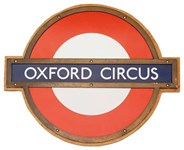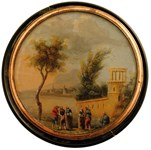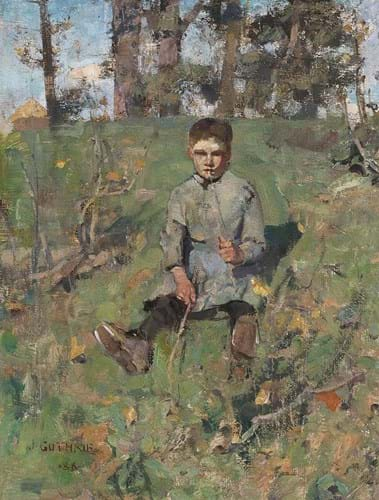
Nestled near the mouth of the River Dee in the south-western region of Galloway in Scotland, the historic town of Kirkcudbright has long attracted artists.
Its reputation as an artists’ colony began in the early 19th century with the Faed family of artists, who were drawn to the lively fishing port with its appealing maze of Georgian architecture, cobbled streets and crooked wynds.
Helped by the introduction of a railway line in 1864 which put Edinburgh and Glasgow within a few hours – the two cities where the major exhibitions and art dealers were to be found – subsequent artists followed, including the influential radical young group of modern painters known as The Glasgow Boys.
Like other principal artists’ colonies in Britain of the same period – Newlyn, Staithes and St Ives – Kirkcudbright’s bustling and ever-changing coastal scene provided plenty of material, as did its varied and unspoilt surrounding countryside of ancient woodlands and undulating fields.
When leading Glasgow Boy Edward Atkinson Hornel was asked why he thought Kirkcudbright was so popular with artists he replied: “Well, it’s a fine old town and not too big, but big enough to keep you from vegetating.”
Works by the Glasgow Boys and other 19th and 20th century artists who lived and worked in Kirkcudbright and the surrounding area are the focus of The Fine Art Society’s annual August exhibition in Galloway.
The Glasgow Boys and Galloway Pictures, which runs until August 29, is the Edinburgh and London gallery’s 43rd exhibition in the region and its sixth held at Harbour Cottage Gallery in Kirkcudbright. Prices range from £1800 to £58,000.
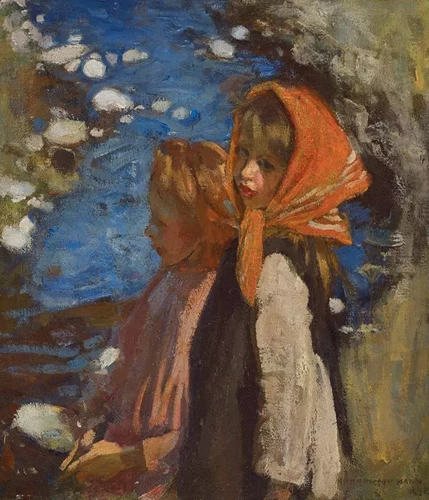
'The Brook' (1892) by Harrington Mann, 15 x 13in (38 x 33cm) oil on canvas – one of works at The Fine Art Society’s ‘The Glasgow Boys and Galloway Pictures’ exhibition.
“When the Glasgow Boys rose to prominence in the 1880s there was a sense of wonder at how a group of Scottish painters could hold such sway in the academies, salons and secessions of western Europe and North America,” says The Fine Art Society’s Jamie Mackinnon.
“Often taking inspiration from Galloway’s landscape, the Glasgow Boys placed themselves at the forefront of British art, primed to take on an aesthetic which signalled the beginnings of Modernism in Scotland.”
The show includes oils and watercolours by a clutch of Glasgow Boys for whom Kirkcudbright and its surrounds became a favoured haunt.
The show’s star is a sketchy and spontaneous oil painting of a boy holding straw by Sir James Guthrie (1859-1930).
He painted the 16¼ x 12in (41 x 30cm) oil on canvas in 1886 during a period of intense self-criticism and frustration which led him to destroy or dismember several larger works and think of abandoning his career as a painter.
Works that survive from the mid- 1880s, such as Boy with a straw, are admired today for their fresh and fluent handling and the insights they offer into Guthrie’s thinking during a turbulent period in the artist’s career.
Another highlight is Harrington Mann’s (1864-1937) The Brook showing two children by a stream painted in 1892, a few years after Guthrie’s work. Mann had begun to make his name as a portrait painter, especially of children, working in London and New York.
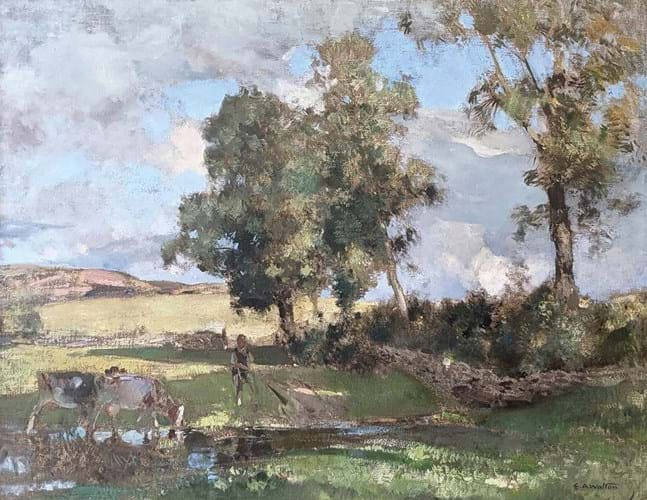
'The Field Loning' (c.1903) by Edward A Walton, 2ft 7in x 3ft 3in (79cm x 1m) – one of works at The Fine Art Society’s ‘The Glasgow Boys and Galloway Pictures’ exhibition.
Other works include a typically exuberant oil by Edward Atkinson Hornel (1864-1933) of children playing on the banks of a lake and a large, c.1903, landscape by Edward A Walton (1860-1922) titled The Field Loning.
Outside the Glasgow Boys are three scenes by domestic genre painter Thomas Faed (1826-1900) – whose family of artists established the colony at Kirkcudbright in the early 19th century.
Also covered are examples by artists Cecile Walton, Mary Newbery Sturrock and Lena Alexander from the Kirkcudbright School that was at its peak in the 1920s, as well as later 20th century works by Joan Eardley, JD Fergusson, George Houston and Jack Knox.


